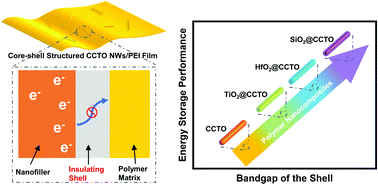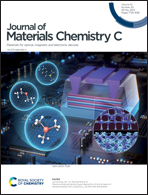Tuning the interfacial insulating shell characteristics in CaCu3Ti4O12 nanowires/polyetherimide nanocomposites for high-temperature capacitive energy storage†
Abstract
A large number of studies have confirmed that encapsulating an insulating shell on the surface of high-permittivity nanofillers can effectively improve the energy storage performance of polymer-based dielectric nanocomposites. Regrettably, there is currently no research to explore how changes in the insulation of a shell will affect the dielectric properties. In this work, three inorganic oxides with systematically varied bandgaps, including SiO2 (SO), HfO2 (HO) and TiO2 (TO), were selected as the shells of CaCu3Ti4O12 nanowires (CCTO NWs). Then the nanowires were added to the polyetherimide (PEI) matrix to yield polymer nanocomposites. The insulating shell can not only inhibit the free charge migration, but also alleviate the electric field distortion in the nanocomposites, thereby dramatically reducing the dielectric loss and improving the breakdown strength. The larger the bandgap of the shell, the more prominent the performance. Consequently, the highly insulating shell enables the nanocomposites to achieve higher discharged energy density (Ud). Moreover, the core–shell structured CCTO/PEI nanocomposites exhibit more excellent dielectric thermal stability. At 150 °C, the Ud of 5 vol% SO@CCTO NWs/PEI can reach 3.73 J cm−3, showing potential as a high-temperature dielectric material.



 Please wait while we load your content...
Please wait while we load your content...